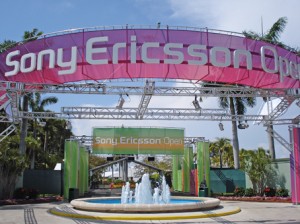KEY BISCAYNE — Around this time of year – when the Indian Wells/Key Biscayne “double” takes place — fans, officials, players and media strike up the conversation of what tournament is considered “the fifth major?”
This begs the questions: what makes the majors, the majors?
The four major tennis tournaments that comprise of the “Grand Slam,” were the four tournaments that had the best player fields and thus, over the years, became the most prestigious. What gave the four majors – the Australian Open, the French Open, Wimbledon and the U.S. Open – the best fields was that those four nations were the four most powerful tennis nations – the United States, Britain, Australia and France being the first four nations to win the Davis Cup. These national championships were usually held just before for just after the Davis Cup matches when each of these respective nations were the Davis Cup champions – or holders – and hosted the Davis Cup Challenge Round (or final) and some preliminary matches leading into the championship round. This guaranteed that a strong field of international players would pepper the tournament fields of these four events. It wasn’t until the 1930s when Australian Jack Crawford nearly swept all four in one year in 1933 and when Don Budge was the first player to turn the trick five years later, that the term “Grand Slam” came into being.

It’s tough to consider the BNP Paribas Open in Indian Wells and the Sony Ericsson Open in Key Biscayne as a fifth major since they aren’t even the biggest tournaments in the United States. (Perhaps co-ed tournaments in Madrid and Rome should receive consideration). However, certain criteria establish these two premier events ahead of the pack in the discussion of the greatest tournaments on the grandest stages in the game.
Combined Event
The Sony Ericsson Open was the first tournament other than the Grand Slam tournaments to host a combined men’s and women’s event when it began in 1985. The tournament was first played over two weeks – like the other major events – and featured a 128-draw. The Sony Ericsson Open and the BNP Paribas Open, which more recently became a combined event, are now played over a week and half and feature 96-player fields.
Player Field
All healthy top players compete in both the Sony Ericsson Open and the BNP Paribas Open, with the glowing exception of the Venus and Serena Williams, who no longer compete at Indian Wells due to this ugly incident from 2001: http://www.worldtennismagazine.com/archives/1811. The strong fields, match-ups and daily schedules of play make these events that much more attractive to fans, media and TV viewers.
Prize Money
The Sony Ericsson Open and the BNP Paribas Open have the most prize money of any event in tennis outside of the four major tournaments and the ATP World Tour Finals. Prize money for both events for 2011 sits at $3,645,000. The ATP World Tour Finals will offer $5,070,000 at the end of this year.
Great Venue
Part of the magic of the Sony Ericsson Open is its location – the island paradise of Key Biscayne, in the shadow of Miami, one of the great international cities of the world. The entire scene and vibe of the Sony Ericsson Open reflects the flavor and international feel of Miami and, in opinion, adds to its prestige. Views of the Miami skyline on television – especially those at night showing the night lights – add the aura of the event. The California desert in Indian Wells, while beautiful, relaxing and charming, does not emit the excitement that Miami does and does not measure up in this regard, in my opinion.
Tournament History/Former Champions
The tournament history of the Sony Ericsson Open dates back only to 1985, but with a combined list of veritable “who’s who” of tennis listed a former champions (Ivan Lendl, Chris Evert, Martina Navratilova, Pete Sampras, Andre Agassi, Roger Federer, Steffi Graf, Serena Williams, Venus Williams, etc.) Indian Wells has a similar list of stellar champions. Big-name players win big-time events. Fans certainly gravitate more to these events with their attention. I remember Greg Garber from ESPN.com telling me last year that the reason why they staff the Sony Ericsson Open for their website was the tremendous traffic the stories produce – meaning massive interest. This year, Garber told me that their web traffic is already up 100 percent from last year.
Tradition, Trophies, Rituals
Certain sporting events have traditions and rituals that separate it from other events. Take for instance, The Masters golf tournament is full of tradition, including the winner being awarded something very unique – the Green Jacket. Another tradition in golf that comes to mind is the Dinah Shore Golf Classic – one of the majors on the LPGA Tour – where the tournament winner annually jumps into the pond on the 18th green after holing out as the champion. Three of the four major tennis tournaments have “named” trophies (the US Open being the exception. The Sony Ericsson Open used to have a “signature” trophy – a round, bowl-like crystal trophy – but with the change to a new sponsor came a newly-shaped, also nameless trophy. Both tournaments are lacking a bit in this regard, but perhaps the introduction of a signature trophy to be given to the singles champions could be introduced, say “The Larry Ellison Bowl” for the winner of Indian Wells, in honor of its tournament owner, or, in Key Biscayne, perhaps the “Buchholz Trophy” in honor of the event’s founder and brainchild Butch Buchholz.
